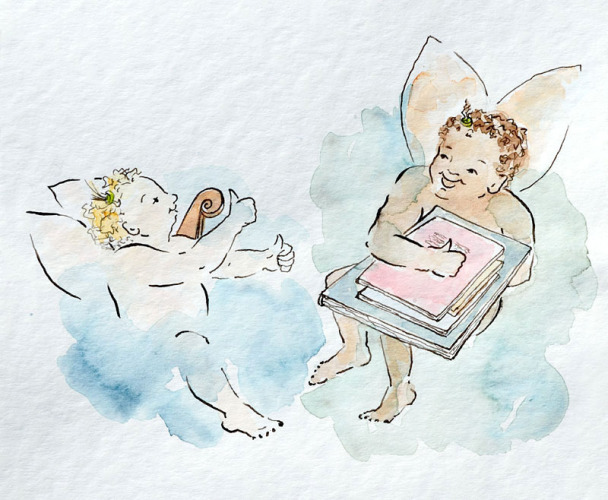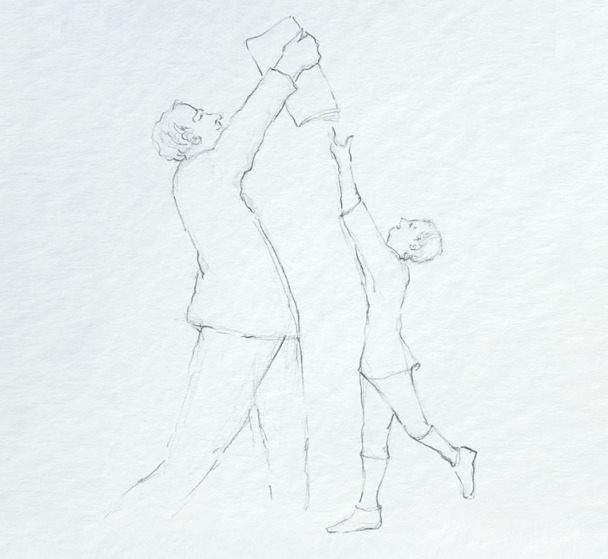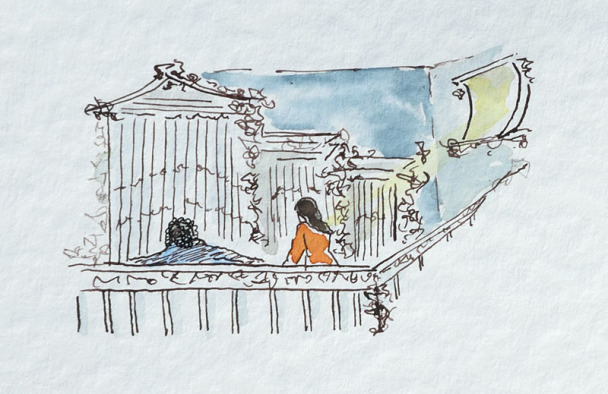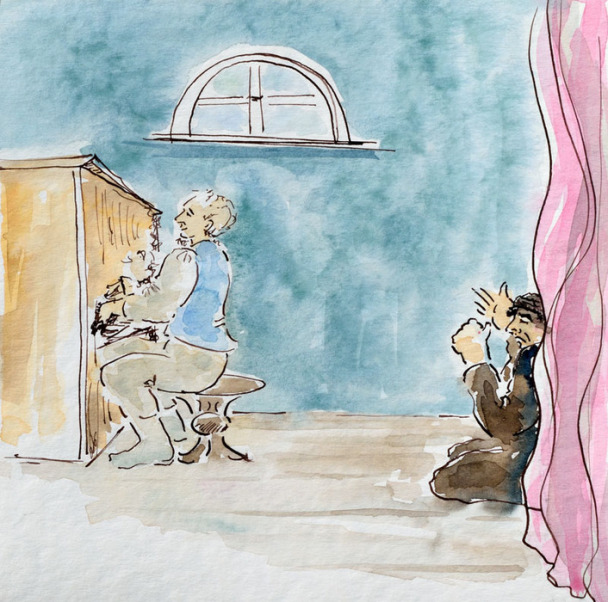
This Whole Page Is Advertisement = Promotion = Commercial
Johann Sebastian Bach for Children: A Story by Balthazar With Music by Veit
By the way, the reading sample starts very far down on this page, but with a click here you are immediately at this point. But first, the two little baroque cherubs should introduce themselves to you personally.
"That's the two of us. On the left, that's my very best friend forever, Veit. And on the right, that's me: Balthazar. I have my book with the rules in my hand. In it are all the instructions that you have to know as a little baroque cherub who is very good at telling stories. Because, of course, I'm not a little baroque cherub who "reads stories just fine". No, what I can do is something completely different. I can tell everything well. And of course you have to learn that first. And then, of course, also practice."
Conveniently, Electronically or Conservatively ... That Is on Paper: How the Bach Biography for Children Begins
"Hello, my name is Balthazar. I'm a little baroque cherub." That's how the very best friend of baroque cherub Veit always begins his stories. That's exactly how Balthazar is able to tell his story about the greatest musician of all time, Johann Sebastian Bach from Eisenach in Thuringia. "I'm a little baroque cherub who's particularly good at telling stories," says Balthazar. And Balthazar makes one of his very famous pauses. "To make everything much more exciting," he says. "Shall I say hello now?" asks a second little baroque cherub, sitting on the little white cloud hovering next to Balthazar's cloud. Balthazar looks at his friend and says, "Yes, Veit, this is the right moment. Veit sits up straight and says, "Hi. I'm Veit. Balthazar is my very best friend. He is very good at telling stories. I'm not so good at telling stories. But I can do something else very well. I'm especially good at making music. Balthazar, explain once how good sounds what I can do ." Veit prompts his friend. "Yes, that's right. Veit does it really well, he plays Johann Sebastian's music really, really well."
The above is one of the exciting stories in the book for children about Johann Sebastian Bach. And right: The person above, at the windowsill, is actually the famous composer Johann Sebastian. That is, the later composer Johann Sebastian Bach. What he is doing, however, should not be revealed here. In fact, he's not allowed to. But he does it anyway. More about that later ... but, I promise, not everything will be revealed! Please click here to go to the store. Please click here to get to the store.
A Cool Bi - o - gra - phy, Part 1
Balthazar now also sits up a little straighter. He now looks again at his audience, which he of course only imagines. For all around the two small, white clouds is only the deep blue, glorious summer sky. But there are no children present. Not even adults can be seen. "Don't you want to say that it's the story of Johann Sebastian Bach that you tell so beautifully? And which exists as a book? Balti? Balti-Ronissimus?"
Balthazar can't believe his ears. Barely a minute has passed and Veit has already thought up another of his many nicknames for his very best friend forever. It's almost exasperating. "Veit," replies Balthazar. "... You're not supposed to call me that." "But it's such fun for me. Go ahead. Tell me about the story of Johann Sebastian Bach. About the bi - o - gra - phy. For children. Don't you want to explain very quickly what a biography actually is? So that all children understand it. Even the little children?" "Good Veit. Actually, I want to start with the story, but you're right. Firstly, I'll explain what a biography is!" "Good," says Veit. He is proud to have contributed something that helps children to understand something very difficult correctly.
Would you have known that Johann Sebastian Bach was not even ten years old when first his mother and then shortly afterwards his uncle and finally even his father died? The smaller of the two Bachs above is Johann Sebastian. And so much is already revealed here: The taller one is the oldest brother of Johann Sebastian Bach. And also here it is about this famous story, in which the young composer actually pilfered something.
A Cool Bi - o - gra - phy, Part 2
Balthazar now has to think for a moment about how best to explain what a biography is: "Well, there are people who were once very important. And they did many great things in life. You need these people first for a biography. You need someone you can tell something about." "Yes, says Veit." In fact, he regularly interrupts Balthazar's stories. It's not polite, but sometimes it makes sense ... and that's just the way Veit is. "And then," Balthazar continues, "... you still need a person to write it all down about that person. Of course, he or she must know everything first ... about the person you want to write about. When you finally know everything about this famous person, then you write everything down. And that is then a book and that is also a biography. So a biography is when you can read everything about the life of another, usually famous, person." "Everything," Veit reflects. "Really everything?". Veit sometimes has really complicated questions. "Anyway, Balti, don't you want to start by explaining who you and I are, how many of us there are ... and what our jobs are anyway?" Children, who perhaps also visit this page of the website, surely want to know that firstly.
This is also the subject of one of the stories in the Bach Biography for Children: "It was back then in Arnstadt. Around 300 years ago, something quite "monstrous" happened in the small Bach city of Arnstadt in Thuringia. In fact, the musician Bach got his first real job there. And a whole lot of trouble. Real trouble," says Balthazar solemnly.
What Little Baroque Angels Do
Balthazar is in a dilemma, because Veit is actually right. But he doesn't really like it when Veit constantly interrupts him. And he would like to finally start the story about Johann Sebastian Bach. But first he has to explain what a biography is. But he has done that in the meantime. However, now Veit also says that he also has to explain what the tasks of the many little baroque cherubs are. And then also how many of them there are. Balthazar takes a breath. He takes a really deep breath. And Vitus, who sees how deeply Balthazar takes a breath, also takes a very deep breath. "I'm sure many children will be grateful when you explain this," says Veit .
"The story accompanying this painting is about two kings and the two best musicians on earth ... at the time. Perhaps it was also the strangest music contest ever in the history of mankind. More ... I will not reveal here!"
"Yes, Veit, you might be right. So I want to do this briefly. Little baroque cherubs have three main tasks. Firstly, there are the little guardian cherubs. There are thousands of them! Oh, what am I saying, hundreds of thousands, actually .... millions! They take care of all people. And sometimes several have to work together so that nothing happens to a single person." Veit nods. After all, he already knew that. "And then there are the music baroque cherubs. They play music beautifully, and they can always do it on several instruments at once. Not at the same time, of course. Some of the little music baroque cherubs can also sing beautifully ... well, actually, they can all sing beautifully. And finally there are the little baroque cherubs like me. They are also specialized. And that is in telling stories. Of course, not every one of the little cherubs knows all the stories. Especially not at the beginning. There are just way too many stories. But the stories that a cherub can tell, they can tell super well. Exciting. So that you are always restless, what will come next. So that you don't really want to take any breaks, just sometimes, when you were hungry, or thirsty ... or you had to use the bathroom." Veit is satisfied with this. Of course, Balthazar can also explain really excellently what tasks all the little baroque cherubs have. He, Veit, could have explained it well, but not as well as his very best friend.
How and When Does It Start?
"And then there are ..." Balthazar continues, ".... there are the many, many little Baroque cherubs, who have many, many other tasks. Some are responsible for breakfast, others are plugging little holes in the socks of the other little Baroque cherubs. And still others take care that it rains on earth once and that the sun shines there again later ... or at least after a few days." Now, however, Veit was getting a little impatient. He hoped that Balthazar would not now also want to describe the task of each cherub, because then he would not have started even next week with the story of this Bach. And he actually wanted that, Balthazar finally now began with the first chapter about the children's book of Johann Sebastian Bach.
Finally: The First Chapter in the Book
Chapter 1
“Hello there. My name is Balthazar. Just Balthazar. My friends call me Balty. I am a little Baroque cherub. There are many of us. We all have very different tasks. I once wanted to become a guardian cherub. But that is a very, very stressful task for a little Baroque cherub. That is why I decided to become a little cherub, who knows really many stories. Also, I am very good at telling them. I could have become a little Baroque cherub who likes to perform music, too. But I found, telling stories is much more exciting. Veit is a little Baroque cherub, too. He is my very best friend.”
That was how little Baroque cherub Balthazar always used to introduce himself to his audience, because actually he always told his stories to many intent listeners: other cherubs, who did not know yet how much fun listening could be. Also, to children. Moreover, sometimes, yes sometimes even to grown-ups, which were “so grown up” that these stories actually, yes actually, were not intended for them. “Hello,” said Veit on his little white neighbor cloud. “I like to play music. I am not that good at telling stories. Come on, Balty, tell the story about the Zipfel-Fagotist,” chattered Veit. “It is called Zippel-Fagottist – with another ‚p’ instead of the ‚f.’ And another ‚t’ later.” “How did you know I would have written it with just one ‚t’?“ … replied Veit. “I know you well – and I am going to save the story about the Zippel-Fagottist for later. Much later. Veit, I am glad that you are in charge of making music. You would start all stories in the middle. Without telling upfront what it is about and who it is about.” “That is true,” replied Veit meekly. He even blushed a little.
“Would you like me to play some music during your narration, Baltylinium?” “Don’t call me Baltylinium, I find that silly. My name is Balthazar. Or Balty … if you prefer that. I don’t call you Veitissimo either, or Veitusselino.” “Could you at least tell what a Baroque cherub is? What is Baroque anyway?” Balthazar had to think. Not everything came instantly to his mind always. But if it came to his mind instantly, he did not know instantly, how to explain it to perfection. Plus, to tell it, so that his very best friend Veit would understand it, too. “Baroque was …” he reflected, but he had already started to speak. So he hesitated a little. “Well, Baroque is what humans called an epoch when everything was a bit more quirky.” “More quirky, I see,” replied Veit and then “… more quirky? What do you mean by that, Balty?” “Well, everything was a bit more playful. And there were curlicues everywhere. Many people liked that back then. Still today, you can see it best at buildings and on paintings. Yes, especially on paintings! They even created picture frames with curlicues and Baroque chairs with curlicues. By the way, this was the time, in which you could discover us little cherubs in many churches. But also in palaces and castles. And also as stone sculptures: sandstone, marble and ... well, I cannot remember another type of stone right now. Also, those curlicues have even been in the music from back then. You can actually “build” such curlicues into the music, too.” “How is that possible?” asked Veit surprised. “I don’t know either. I read that somewhere. But Johann Sebastian Bach – he has been really great at doing that.”
“Jo - hann, Sebas - ti - an … plus Bach,” said Veit slowly. “I have heard that name before. I believe, it is written somewhere in my music book. I think he wrote a song – no, two songs – which I have practiced once on my violin.” Veit was very excited. “So he made Baroque?!” “No, no,” said Balthazar. “Johann Sebastian Bach lived in this age that we call Baroque today. He did not make Baroque. He made music.” Veit already interrupted Balthazar again: “So you mean he performed music. On a violin or a piano, for example.” “No,” said Balthazar, “… I mean this Johann Sebastian made music. He invented music so to speak. However, that is what the story is all about. The story which I want to tell you now.”
Veit was excited to hear, how and most of all when it started, with the Baroque and with this music inventor. “Where does this Johann Sebastian Bach live?” Veit was thrilled and wanted to know not just more, he wanted to know it right away. “Today Bach is not living anymore,” said Balthazar. “That is sad. Then he probably doesn’t invent music anymore, does he?!” “No, he just can't. However, he wrote so much of great music that more and more people listen to that music. Now please, do not drive me crazy with your questions. Otherwise, I can never start at the beginning of this great story. Just make yourself comfortable, fluff your little cloud and perk up your ears. Humans like Johann Sebastian Bach are not many around. Moreover, they are not born very often. In fact, it is a very, very, very rare thing to happen. Almost never.” Almost never, that was rare enough for Veit. He knew never. Almost, too. “Then” … he sputtered, “… this Bach was someone really special? Someone unique to this world?” Even though Baroque cherubs had really much, much time available, Balthazar impatiently shook his head, because Veit already interrupted him again. He let his wings drop a little, but then he smiled again after all, and now he fluffed his cloud, too. So his cloud was also cuddly and cozy. “Do you want to hear the story now? The one about Johann Sebastian Bach? And that is to say from the very beginning? Or would you rather ask questions and I tell you everything in advance? And the whole story is spoilt after that because then you will know everything somehow upfront?” Veit giggled and beamed shortly after that over his whole little cherub face and said solemnly: “Balthazar, my best friend, please begin with your story, and I promise not to interrupt you again. Actually, I will rarely interrupt you. Well, what am I saying? I will probably have one question already after your first sentence – but we can at least give it a try. I will try hard. Promise.”
Chapter 2
Balthazar and Veit had made themselves really comfortable, both on their own little white cloud. Veit looked at his friend, full of expectation. “Oh, there’s one more thing,” said Veit when Balthazar took a deep breath, to begin with his story. “What is it?” Balthazar rolled his eyes. “If there is something that I quite don’t understand – may I interrupt you with a question in this case? I wouldn’t understand the whole story otherwise.” “Of course you may ask. You wouldn’t understand the whole story otherwise,” parroted Balthazar and took another deep breath. And there it was, the first question. Just like in school, Veit raised his hand clearly visible. However, he did not wait at all, before asking his question. „If this ...“ he started, “…if this is a story, is it at least a little true? Or is this the fairy-tale of Johann Sebastian Bach?” Balthazar smiled with his typical Baroque cherub smile, maybe even a bit impishly. He shook his head. “Most of it is true!” With that answer, he wanted to get a little bit out of this question. „However …“ inferred Veit „… some parts are a little faked, too?”
Balthazar had to reflect. He did not have to reflect, whether a part of the story was faked. He thought what would be the best way to explain it to Veit. “Look, Veit, a fairy-tale is a story that is not true. In it, there can be wizards, fairies, and trolls. Or witches, not all of them are bad.” Balthazar tried not to scare his very best friend, Veit. He thought he would not alarm him by mentioning dragons. He did not talk about dragons. With good cause. “I am a little Baroque cherub who tells stories … and stories are no fairy-tales. Well, mostly. Usually, such stories are events that happened a long time ago. Often, these things happened even really many, many years ago. The story of Johann Sebastian Bach, for example – one half is more than 300 years old, the other half is more than 250 years old – this story really happened.”
Balthazar had second thoughts about his strange description. Of course, Veit also became wary. “How does that work?” “Well,” said Balthazar, “Johann Sebastian Bach was born more than 300 years ago and lived until a bit more than 250 years ago.“ It did not sound very convincing. Also, Veit could not really follow his friend. “So, the story of Johann Sebastian, which I am about to tell you, happened a long, long time ago. To make it really engaging, I personally ...” – Balthazar sat absolutely upright – “… made it much more exciting,” he said ceremoniously. “That is what I learned. That is why I am a little Baroque cherub, specializing in telling stories.” “And I am a little Baroque cherub who is great at performing music,” said Veit, even though this statement did not really fit here. “Everything I am about to tell you …” continued Balthazar, “… actually did happen hundreds of years ago. However, I want you to have real fun while listening. That is why I made a few things a bit more exciting here and there.”
Balthazar grew a bit impatient. He was eager to begin his story. However, Veit had a seemingly endless amount of questions. But, right at this very moment, when Balthazar expected the next question – Veit … was done. He looked at Balthazar with excitement.
Balthazar took a deep breath. Actually, he took a deep, a very deep breath: “Once upon a time ...” “But that’s how fairy tales start,” snorted Veit. However, he quickly realized that Balthazar was a bit annoyed and maybe even a little bit angry. “And so do real stories,” Balthazar resumed. “So – once upon a time – a long, long time before Johann Sebastian Bach lived, there was a small village in Thuringia. To find Thuringia, you just have to find the middle of Germany and go east a little,” explained Balthazar. “This small, cozy village was called Wechmar. Wechmar was located right next to another, beautiful, way bigger community called the city of Gotha. That was a long, long time ago – even more than 400 years! Of course, these places still exist today.
Back then, life was much, much harder and people often had to leave their homes due to wars. Moreover, because of different religions, too. Always the weak and helpless were ejected from home by the big and strong.” “I do not understand that …“ mumbled Veit, while listening attentively. “Why do big and strong people eject the weak and helpless from their homes?” “Sorry Veit, I am afraid that is too difficult to explain right now,” said Balthazar while shaking his head. “Plus, that does not really matter in the story anyway. Maybe we will both understand that better when we are grown up. I ... well, I do not know either.
What is important is that in the year 1600, maybe a few years sooner or later, the great-great-grandfather of our famous musician moved to this small village of Wechmar next to Gotha in Thuringia in Germany.” “That sounds funny, I have never heard of such a great-grandfather. Did he get older than 100 years? This Johann Sebastian and by the way what was his last name?” “Bach,” said Balthazar. “Or did he get 150 years old? Or maybe even 200years?” continued Veit.
“Veit,” Balthazar admonished his friend. “Johann Sebastian and his great-great-grandfather did not know each other. Of course, his great-great-grandfather died long before Johann Sebastian was born. That was in the year 1619. He passed away in the year 1619. In Wechmar. However, before that, he was a baker in Wechmar. He also used to be a baker in his previous home, from which he had to flee. Because of his religion.” “So, where did he live before that?” wanted Veit to know … and what was this gramps of Johann Sebastian called?” “In Hungary,” replied Balthazar at cyber speed, answering Veit’s first question. “It wasn’t Johann Sebastian’s grandfather, but his great-great-grandfather.” “Yeah, that’s what I meant. So what was his name?”
“His name was Veit.” “You said Veit?“ asked Veit disbelieving. “That is my name. That is really my name!” Veit was excited: “Okay, that was Veit Bach. His last name was Bach, too. Am I correct?” Veit was really inside the story. “And he was a baker, didn't you say so?” “Yes, he worked in a mill in Wechmar. But not just he, but one more person, whose name was Hans Bach and who was living with him. That was the son of Veit Bach.” Veit smiled a little, but suddenly he snorted with laughter. Then we may erase one of the “greats,” if that was the son of Veit. Then Hans was the great-grandfather of Johann Sebastian. Has he met Johann Sebastian after all?” “No,” said Balthazar with a pleasurable smile on his face. He also lived too far in the past. The name of Hans' son – by the way – was Christoph. However, let's go on with the story.
So it was Veit – and that is what Johann Sebastian said personally – who was the first that made music in the Bach family. Actually, he wasn't just the first that made music, but even the very first. While Veit ground the grain in the mill, he made music on a cittern. Back then, many things had different names, and so this cittern was called a “Cythringen.” This Cythringen was a little bit different to what a cittern is today. Johann Sebastian reported that Veit could play very well by the beat of the millwheel. Because there was a steady rattle when the water flew over the water wheel so evenly.
And because the daddy of Hans was playing so beautifully, Hans had this fun as well and he started to make music, too. Therefore, Hans was the second musician in the family. Making music was what he could accomplish well. Really well. He was so good that people in his village called him “Hans, the musician,” or better “Hans, the Spielmann” in German.” “Where exactly did these two live, before they came to Wechmar?” asked Veit. Balthazar replied: “That is, what they don't know exactly. That is what I don't know. Actually … nobody knows. Where exactly in Hungary both lived, is what became a riddle for many, many scientists. And they still puzzle about it today."
Veit became a little impatient on his cloud and took a deep breath. “Is it now about more of those gramps of Johann Sebastian? Or is he now showing up in the story?” “Just wait a second. Don't be so impatient,” reproved Balthazar. However, it was absolutely heartily. “It is important, as this great-great-grandfather is the reason, why Johann Sebastian became such an outstanding musician. If you throw in a little more patience, the story about the Zippel-Fagottist is coming soon. Plus, the story, when Johann Sebastian was sent to jail. As well as the story when young Johann Sebastian had to unleash his epée. However, first of all – we have to start from the very beginning. If not – we would mess up everything! So, where have we been? Well, yes, Hans the Spielmann. That is what they called the son of Veit in Wechmar. It goes without saying he had children, too, but I tell you about those another time. However, it is important: Of course, the children of Hans made music, too. His aunts and uncles and nephews and cousins made music as well. So many children, grandchildren, and great-grandchildren plus additional great-great-great-grandchildren of Veit Bach made music, so that these Bachs are the largest and most famous family of musicians in the world. Still today.
There is something more: Johann Sebastian Bach once himself put together a list, to count all relatives who made music. He wrote down all men – very young ones and the older ones, too – which he recalled. The only important fact he considered was that they should have been capable of performing music. After that, he decided to name this list with a really funny name: He called it the “Ursprung” in German, which is the beginning. More precisely: “The Ursprung of the Musical-Bachish Family,” which is the “Beginning of the Musical-Bachish Family.” However, honestly, you do understand this comical name still today. Even if nobody would say it that way nowadays anymore. However, women were not present in this list: Not Johann Sebastian's mother, who belonged to a musical family, too. Not Johann Sebastian's first wife Maria Barbara, who was a singer and not his second wife Anna Magdalena, who was even a professional singer. But … that is how it was back then.
“Strange!” said Veit silently.” “Of course not all of those first musical Bachs lived in the little village of Wechmar. Because meanwhile all those family members didn't just make music for fun, but they made music for money, too. That is what was possible in a church or at sovereign courts.” “What in the world is a sovereign court?” Veit scratched his head because he had never heard such a word before. “Sovereigns.”
“I try to keep it very simple for you, Veit. Back then, there were aristocratic people, and there were regular people. Regular people, for instance, were bakers, farmers, and merchants. However, there were also humans, who owned palaces and castles. They also owned much, much land. These people had much, much money, too. There are some of them still around today: They are called nobles today, and regular people love to inform themselves about those nobles in newspapers, in magazines and especially on TV and on the internet.
However, one detail was different back then: Today nobles do not own humans anymore. That was different back then. A human was a possession of a regent at a sovereign court.” “Now please, what is a regent?” “A regent is a person that rules. The one who rules his court and the land around. And even those were not equal. There were Emperors and Kings, Elected Sovereigns and Sovereigns by birth. Dukes and Earls and Barons, plus I don't know, what more.” “Okay ... then this is clear now,” stated Veit thoughtfully and he was really proud of knowing such strange things now. You never knew, when you might impress someone much with this knowledge.
“Aha, sovereigns! So you could make music for those noble folks. Sure, moreover for a community.” However, even in a town could live no twenty sovereigns. Because that would be really funny. That was what Veit only thought, that was not, what he said loudly. “So,” Balthazar continued, these sons and daughters and grandchildren and great-grandchildren of Veit spread more and more over Thuringia. It was astounding: These Bachs were so good at playing music meanwhile, that they were hired right away everywhere … just for the reason, because their last name was Bach! Of course, they had to be capable of performing music.
However, until today there are – and have been – around 150 musicians. Most have or had the last name of Bach and made music. They did not only make music in Thuringia, but they also hiked to towns outside Thuringia and some of them even traveled by carriage. And they moved. First to the Netherlands, Milan in Italy and London in Great Britain. Later, they even traveled with ships to the far, really far away America.
“That is too fast for me.” Veit took a deep breath: “Just wait for a little, and I am finished with chapter one.” “Then is it Johann Sebastian's turn?” “Yes Veit, then it is Johann Sebastian's turn,” said Balthazar with pleasure. “One of these Bachs finally … was Johann Ambrosius Bach. Johann Ambrosius Bach was the father of our Johann Sebastian.”
“Do we want to have a timeout?” proposed Veit. “We could have a drink in our break, what do you think, Balty?” The little Baroque cherub Balthazar was excited by this idea of his very best friend. Not with the part to stop telling the story for a while, because he was way too much into it. However, the part with the drink is what he really liked. “What do we want to drink?” asked Veit. “Tee or juice? And if yes … which one?” he fooled around. They both decided for ice-cold grape juice. “Telling stories makes you thirsty,” said Balthazar. “However, listening to you makes me thirsty even more,” Veit confirmed.
“Johann Ambrosius is a funny name,” said Veit and added “… but Veit is, what I find a little old-fashioned, too. I would rather be called Sven, or Tobi or Kevin.” Balthazar reflected, and he replied: “Yes, I didn't like my name as well in the beginning, but today it is something really special, because not that many little Baroque cherubs have names like I have.” Veit reflected: “A little Baroque cherub, whose name is Mickey, or Minnie or Goofy … that would really be a funny name for a Baroque cherub. Have there been roque names around back then in this rouqy time?” “It is Ba - roque and by the way, what is a ‘rouqy name,’ Veit? Humans always found first names in certain epochs more fashionable and sometimes less fashionable.” “So, I find …” Veit interrupted Balthazar, “… so I find Veit not that bad anymore. And the same is true with Balthazarius.” Veit bubbled over with laughter, and he well knew that there was one thing Balthazar did not like: That was if somebody fooled around with his name.
“However: Johann Ambrosius is funny.” Veit had not accomplished the chapter with the funny names yet. “But that was his name.” “So he lived in that Wech?” “In Wechmar? No, Johann Ambrosius Bach did not live in Wechmar. First, he was living in Erfurt, after that – later – he moved to Eisenach." “Didn't we want to take a timeout?" said Balthazar to Veit. Both had a deep draft of their delicious grape juice. “And we need cookies! For refreshment." “No bad idea. Okay, cookies with the birth of Johann Sebastian Bach. Then let us celebrate this Johann Sebastian. However, first, we take a time out." Balthazar and Veit ate the various cookies alternatingly. Actually, it was a real cookie variety, but they did not fight, because little Baroque cherubs almost never fight and second, because some of them liked these cookies best, the others preferred different ones.
There are 33 Bach calendars and soon even hundreds of Bach gifts and music gifts with the designs of the Publishing House "Bach 4 You". Please click here and you will get to all five stores.
Especially T-shirts with Bach motifs quite obviously appeal: especially the T-shirts with the Bach seal. Close by, there are then also the US-style calendars ... here you can learn more.
None of the 99 calendars of the Publishing House "Bach 4 You" fits better on this page: none of the 33 composers' calendars, none of the 33 music calendars and none of the other 33 Bach calendars. Because ... it is the children's calendar in the matter of music regarding the biography of Johann Sebastian Bach. 33 Bach calendars: three sizes, 2024 + 2025, two styles. To the stores.
End ... of Advertisement ... of Commercial ... of Promotion










